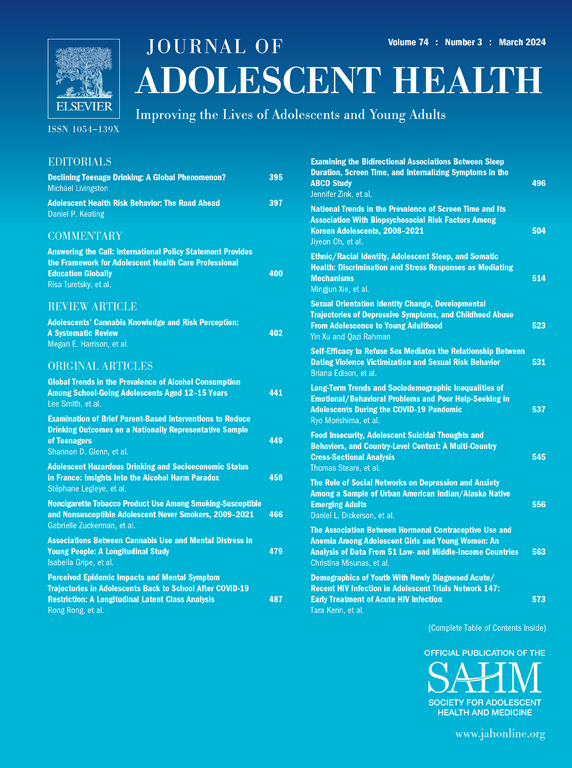美国危机怀孕中心与大学的距离,2021年。
IF 5.5
2区 医学
Q1 PEDIATRICS
引用次数: 0
摘要
目的:由于危机怀孕中心(CPCs)以高校学生为目标,本分析的目的是通过驾车距离描述美国高校和CPCs之间的空间接近性。方法:使用CPC地图和美国教育部综合高等教育数据系统调查的2021年数据,我们根据驾驶距离(英里)在每个公立和私立非营利CU周围生成缓冲区,并检查每个缓冲区内的CPC位置。我们计算了每个CU到全国和各州最近的CPC的距离。然后,我们计算了3英里内至少有一个CPC的cu的女本科生总数和百分比。结果:共纳入CPCs 2546例,cu 3391例。在全国范围内,到最近的CPC的驾车距离中位数为3.5英里。在67%的州,到最近的CPC的最短驾驶距离不到0.5英里。大多数(51.5%)女大学生就读的大学在3英里内就有一个分校。在3英里内至少有一个CPC的cu的百分比在私立非营利机构,学生人数较多的cu,授予博士学位的cu以及位于中西南和中大西洋次区域的cu中最高。讨论:cpc位于靠近cu的位置。有必要努力提高对cpc及其风险的认识,并帮助学生找到优质的护理和信息来源。本文章由计算机程序翻译,如有差异,请以英文原文为准。
Proximity of Crisis Pregnancy Centers to Colleges and Universities in the United States, 2021
Purpose
Since Crisis Pregnancy Centers (CPCs) are known to target college and university (CU) students, the purpose of this analysis was to describe the spatial proximity between CUs and CPCs in the United States by driving distance.
Methods
Using 2021 data from CPC Map and the US Department of Education's Integrated Postsecondary Education Data System survey, we generated buffer zones around each public and private not-for-profit CU based on driving distance (miles) and examined CPC locations within each buffer. We calculated distances from each CU to the nearest CPC nationally and by state. We then calculated the total number and percentage of female undergraduate students enrolled in CUs with at least one CPC within 3 miles.
Results
A total of 2,546 CPCs and 3,391 CUs were included in the analyses. Nationally, the median driving distance to the nearest CPC was 3.5 miles. In 67% of states, the minimum driving distance to the nearest CPC was less than 0.5 miles. Most (51.5%) undergraduate women were enrolled in a CU with a CPC within 3 miles. Percentages of CUs with at least one CPC within 3 driving miles were highest among private-not-for-profit institutions, CUs with higher student enrollment, doctoral degree conferring CUs, and CUs located in the West South Central and Middle Atlantic subregions.
Discussion
CPCs were located in close proximity to CUs. Efforts to increase awareness about CPCs and their risks and assist students in finding quality sources of care and information may be warranted.
求助全文
通过发布文献求助,成功后即可免费获取论文全文。
去求助
来源期刊

Journal of Adolescent Health
医学-公共卫生、环境卫生与职业卫生
CiteScore
10.40
自引率
3.90%
发文量
526
审稿时长
46 days
期刊介绍:
The Journal of Adolescent Health is a scientific publication dedicated to enhancing the health and well-being of adolescents and young adults. Our Journal covers a broad range of research topics, spanning from the basic biological and behavioral sciences to public health and policy. We welcome a variety of contributions, including original research papers, concise reports, literature reviews, clinical case reports, opinion pieces, and letters to the editor. We encourage professionals from diverse disciplines such as Anthropology, Education, Ethics, Global Health, Health Services Research, Law, Medicine, Mental and Behavioral Health, Nursing, Nutrition, Psychology, Public Health and Policy, Social Work, Sociology, and Youth Development to share their expertise and contribute to our mission of promoting adolescent health. Moreover, we value the voices of young individuals, family and community members, and healthcare professionals, and encourage them to submit poetry, personal narratives, images, and other creative works that provide unique insights into the experiences of adolescents and young adults. By combining scientific peer-reviewed research with creative expressions, our Journal aims to create a comprehensive understanding of the challenges and opportunities in adolescent and young adult health.
 求助内容:
求助内容: 应助结果提醒方式:
应助结果提醒方式:


